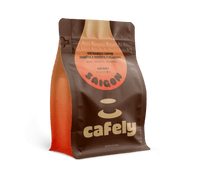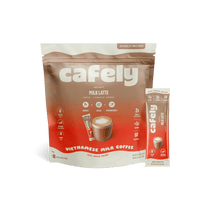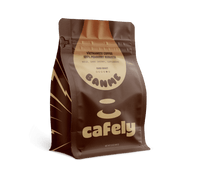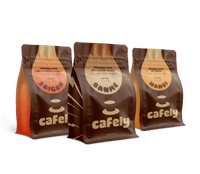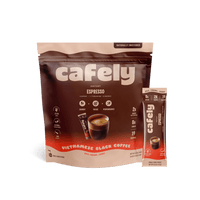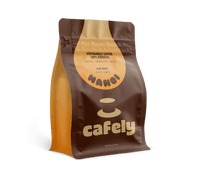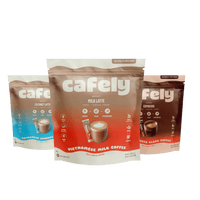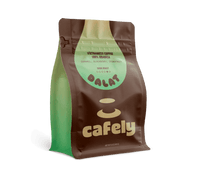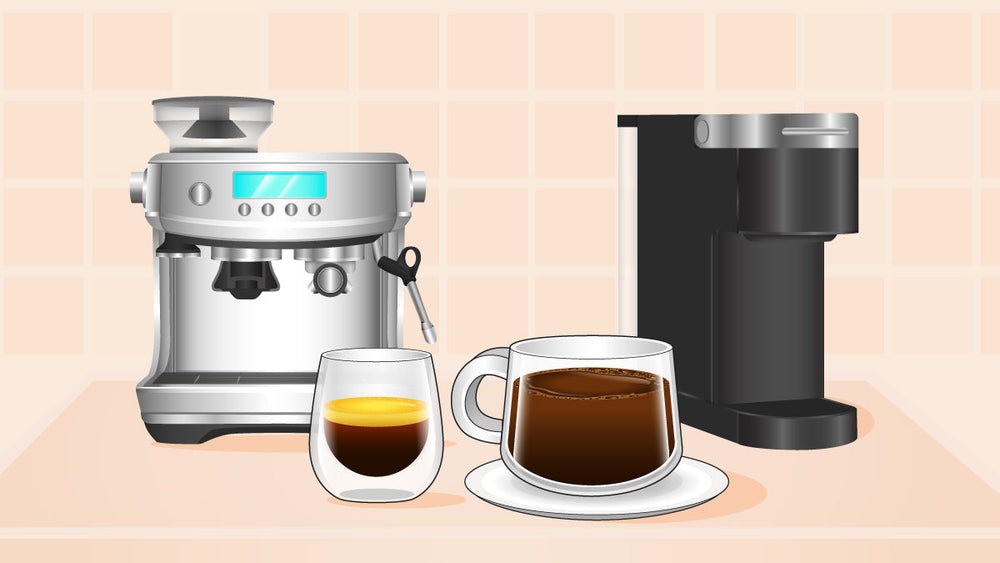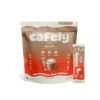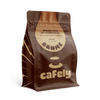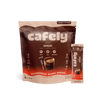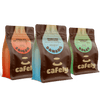Espresso and regular coffee are typically made from the same beans but are vastly different in appearance, flavor, and tradition. The key difference lies in how the beans are brewed.
Espresso uses high pressure to force water through finely ground coffee, while regular coffee relies on gravity or steeping for a slower, gentler brew.
Espresso coffee is made using an espresso machine, though a moka pot is similar. So-called “regular coffee” is usually made with an immersion brewing method, such as a drip coffee machine, though pour-over and the French press are also used.
In this guide, you'll learn all the nuances that separate espresso from regular coffee and how to use each brewing method like a pro.
For premium espresso-grade coffee, check out our BanMe or DaNang beans (available in both pre-ground and whole-bean).
For instant, barista-grade espresso — check out our new VC2 (formulated with functional mushrooms and adaptogens for added benefit).
What is Espresso Coffee?

Espresso is a concentrated form of coffee made by forcing hot water through finely ground coffee beans at high pressure (usually around 9 bars). It’s made using a specialized machine and can be consumed black, as a highly-caffeinated "shot," or with steamed milk as a latte, cappuccino coffee, or flat white.
Espresso coffee is thick, rich, and dark. A good espresso shot will have a golden, caramel layer of crema on top — a rich, dense foam that forms during the brewing process. Its bold flavor and high intensity make espresso a favorite for those who want a quick, robust caffeine hit.
This beverage is typically made from dark roasted 100% arabica coffee or an arabica-rich blend. Arabica beans offer the sweet, smooth flavors needed for such a concentrated shot of coffee. It’s best to avoid 100% robusta coffee because the resulting espresso will be overly dark, strong, and bitter.
Most people consume espresso and espresso-based beverages at a coffee shop. How much coffee shops make will depend on what people consume. It’s less common for people to drink espresso at home because the equipment needed to brew it is expensive, high-maintenance, and takes up a lot of space.
With that said, a good instant espresso blend comes close to the real thing and can be made in seconds, or you can use a moka pot, which is more economical and easier to manage.
What is “Regular” Coffee?
“Regular” coffee typically refers to drip-brewed coffee made with a machine or a brew made through submersion using a pour-over or French press. These methods involve steeping or filtering water through coarsely ground coffee at lower pressure and longer brew times.
Regular coffee is smooth, mildly caffeinated, and has more volume. It’s typically consumed black or with a small splash of milk. It’s ideal for sipping slowly and tends to highlight more subtle tasting notes compared to espresso.
Most people drink “regular” coffee at home or throughout the day at work because it’s quick, easy, and cheap to make. Drip coffee machines, French presses, and other immersion brewers are cheap, easy to maintain, and don’t take up much room.
Related: Pour-Over vs. French Press vs. Phin — Understanding Their Differences
Espresso Vs. Regular Coffee: The Differences
Although espresso and regular coffee are often made from the same beans, they differ significantly.
The differences between espresso and regular coffee can be noticed in the way each tastes, their strength, and how they’re made.
Espresso and regular coffee differ in the following ways:
- Brewing method
- Roast
- Grind size
- Coffee-to-water ratio
- Strength
- Flavor
- Serving size
- Caffeine content (per ounce)
Below is a quick overview of how each of these beverages differ:
|
Espresso |
Regular Coffee |
|
|
Brewing Method |
High-pressure extraction (≈9 bars) using an espresso machine (25–30 sec) |
Immersion or gravity-based methods (drip, pour-over, French press) |
|
Very fine (like powdered sugar) |
Medium to coarse, depending on the method |
|
|
Roast |
Dark roast (Espresso or French roasts are common) |
Any roast, from light to dark, depending on personal preference |
|
Coffee-to-Water Ratio |
1:2 (strong and concentrated) |
1:15 to 1:20 (more diluted, larger volume) |
|
Flavor & Body |
Bold, rich, intense, thick crema, often chocolatey or nutty |
Milder, more nuanced, wider range of flavor notes |
|
Serving Size |
1–2 oz (30–60 mL) |
8–12 oz (240–350 mL) |
|
Caffeine (per oz) |
~63 mg per oz — highly concentrated |
~12–16 mg per oz — less concentrated but more total caffeine per cup |
|
Caffeine (per cup) |
~63–125 mg (single/double shot) |
~90–150 mg (8 oz cup) |
How to Make Espresso Coffee

Making espresso isn’t as complicated as you might think. However, it takes a certain level of skill and knowledge. It also requires an espresso machine, which is a costly investment.
Here’s a brief rundown of how to make espresso coffee:
Ingredients & Equipment
- Espresso Machine — An essential item. They are available in a range of shapes and sizes and automatic or manual versions.
- Coffee Grinder — A fine grind size is required for espresso. This can only be achieved with a burr grinder. Most espresso machines have a burr grinder incorporated into their design.
- Weighing Scale — Precision matters in espresso brewing. A digital weighing scale capable of weighing in 0.5–1 gram increments will ensure each shot is consistent.
- Tamper — A tamper is used to pack the coffee into the portafilter evenly.
- High-Quality Coffee — Opt for freshly roasted, whole-bean coffee. 100% arabica, such as Cafely DaLat, or a well-balanced blend like Saigon OG, are good options.
- Water — Make sure to use fresh, cold, filtered water. This will produce the best extraction and keep your machine free from mineral deposits.
1. Prepare Your Espresso Machine
First, turn on your espresso machine to heat it up. Depending on the machine you own, this can take anywhere from five to 30 minutes.
Fill the reservoir on your machine with fresh, cool, filtered water. Avoid using water straight from the faucet — this will eventually lead to mineral buildup, which can damage the machine over time.
2. Measure & Grind the Coffee
Most espresso makers have a built-in burr grinder and a hopper for whole beans. Some even have automatic dosing for single and double shots. If your machine has this, grind a single or double dose into your portafilter.
If your machine doesn’t have automatic dosing, weigh out nine grams (single shot) or 18 grams (double shot) of coffee. Then, grind the beans to a fine consistency — similar to powdered sugar.
3. Prepare Your Portafilter
Once you’ve ground the coffee, add it to your portafilter. Using your tamper, lightly press the grounds down with firm, even pressure. Avoid over or under-tamping and try to be as consistent as possible so a firm, even puck is produced. This ensures the best possible extraction.
4. Brew the Espresso Shot
Lock the filled portafilter into the group head of your espresso machine. Begin to pull the shot. Aim for an extraction time between 25–30 seconds for the best results.
The coffee stream should be steady, free-flowing, and caramel-colored.
5. Evaluate & Enjoy Your Shot
Your espresso should look dark, rich, and thick with a smooth, dense, caramel-colored crema (foam) on top. Your shot should taste bold, robust, and intense but not overly bitter.
If your espresso tastes too bitter, it may be over-extracted. If this is the case, apply less pressure when tamping or increase the grind size slightly.
If your espresso tastes weak and watery, it’s likely under-extracted. If this is the case, apply more pressure during tamping or decrease your grind size slightly.
If your espresso tastes sour or overly acidic, assess the quality and freshness of your coffee — sour, acidic-tasting coffee is usually past its use-by date.
How to Make Regular Drip Coffee

Making a cup of regular coffee is simple. It can be made using a variety of different brewing methods, but the most popular and easiest is using a drip coffee maker. You don't need barista-level skills or knowledge to make a cup of drip coffee, nor do you need much money.
Here’s how to make a cup of “regular” coffee using a drip coffee machine:
Ingredients & Equipment
- Drip Coffee Maker — These automatic coffee makers come in a wide range of styles and sizes. Prices range from as low as $30 up to $150. Even basic drip coffee makers are capable of brewing good coffee.
- Coffee Filters — Filters are available in paper, cloth, or mesh. Paper filters offer the easiest cleanup and often the best results.
- Coffee Grinder — The best brews are made using freshly ground coffee. Use a coffee grinder to produce a medium grind. Burr grinders offer the most consistent results, but blade grinders are typically cheaper.
- Coffee Measure — A simple coffee scoop allows you to dose the grounds accurately.
- High-Quality Coffee — Opt for a high-quality whole-bean coffee. 100% arabica offers a smooth, sweet brew, while authentic robusta coffee produces a strong, dark, bold brew. Blends such as DaNang balance the qualities of both beans.
- Water — Use fresh, filtered water in your drip coffee maker. This improves the taste of your brew and prevents mineral deposits from damaging your machine.
1. Prepare Your Machine
First, make sure your drip coffee maker is clean and free from stale grounds and residue. Then, fill the reservoir to the fill line with clean, fresh, filtered water.
Rinse a paper filter with water, then place it in the filter basket and slide a clean carafe underneath. If your machine needs to preheat before brewing, switch it on. If it doesn’t require pre-heating, do not switch the machine on — it will probably begin a brewing cycle.
2. Measure & Grind Your Coffee
The best cup of regular coffee is made with high-quality whole beans that have been freshly ground. For drip coffee, the best coffee-to-water ratio is 1:16 — one gram of coffee for every 16 grams (or mL) of water.
Grind your beans to a medium consistency similar to sea salt. If you don’t want to grind your own coffee, select a fresh pre-ground variety for the best results.
Here’s a rough guide for how much coffee and water you’ll need:
|
Carafe Size (Servings) |
Coffee (Tbsp & Grams) |
Water (Cups & mL) |
|
2-Cup Carafe |
4 tbsp (28 g) |
2 cups (470 mL) |
|
4-Cup Carafe |
8 tbsp (56 g) |
4 cups (950 mL) |
|
6-Cup Carafe |
12 tbsp (84 g) |
6 cups (1.4 L) |
|
8-Cup Carafe |
16 tbsp (112 g) |
8 cups (1.9 L) |
|
10-Cup Carafe |
20 tbsp (140 g) |
10 cups (2.2 L) |
3. Brew the Coffee
Add your ground coffee to the filter basket of your machine, making sure it’s level and loose. Then, turn on your machine and begin the brewing cycle.
Your machine will heat up and automatically start dripping water over the grounds. Depending on your machine and the amount of coffee you brew, the process can take anywhere from two to 10 minutes.
4. Serve & Enjoy
Once your coffee maker is done brewing, remove the carafe and pour yourself a mug. You can sweeten with sugar or syrup and cream with milk if desired.
Most machines also come with a hot plate — this allows you to keep a carafe of fresh coffee warm for an hour or two.
FAQs: Espresso vs. Regular Coffee
Want to learn more about espresso and other types of coffee?
Read through the answers to the frequently asked questions below.
1. Is Espresso the Same as Drip Coffee?
No, espresso is not the same as drip coffee. Espresso is a concentrated shot made by forcing hot, pressurized water through finely ground coffee. Drip coffee is an immersion brew made by slowly pouring hot water over coarse-ground coffee.
2. How Much Caffeine is in Espresso?
There is approximately 75 mg of caffeine in a shot of espresso. However, its exact strength can vary depending on the type of coffee and the extraction time used.
3. How Much Caffeine is in Drip Coffee?

There is around 90 mg of caffeine in an 8-oz (240 mL) serving of black drip coffee. However, the caffeine content can be as low as 60 mg and as high as 200 mg, depending on the bean, coffee-to-water ratio, and type of drip brewer used.
4. What's the Difference Between Pour-Over & Drip Coffee?
Pour-over and drip coffee are similar. They are both made by pouring hot water over ground coffee, and both require paper filters.
However, drip coffee is made in an automatic drip coffee maker, and pour-over coffee is made with a pour-over device such as the Hario V60, which requires manual brewing (boiling and pouring the water yourself).
Most people agree that pour-over coffee tastes more complex than drip coffee — likely due to the slower, more controlled extraction process.
5. Can You Make Espresso With a Moka Pot?
While you can't make a traditional espresso without an espresso machine, the moka pot does create a similar concentrated shot of coffee. You won't produce the same rich crema with a moka pot, but you will produce a dark, bold, strong shot similar to espresso.
6. Can You Make Espresso With Instant Coffee?
No, you can't make a true espresso with instant coffee. However, you can produce a similar brew by using an instant espresso blend such as our Vietnamese Coffee 2.0 (Instant Espresso).
7. Can You Make Iced Coffee With Espresso?
Yes. Espresso is an excellent choice for making iced coffee. Simply cool an espresso shot to room temperature, pour over ice, and dilute with milk.
8. What's the Best Coffee for Espresso?
Espresso is best made with a 100% arabica, such as DaLat, or an arabica-rich blend, such as DaNang. The best coffee for a perfect espresso should be high-quality, dark-roasted coffee that's freshly ground just before brewing.
9. What's the Best Coffee for Drip Coffee?
The best coffee for use in a drip coffee maker should be freshly roasted, high-quality, and whole-bean.
The type of coffee you use is up to you. 100% arabica offers smooth, sweet, creamy flavors, while 100% robusta, such as HaNoi, provides dark, bold, bitter flavors with a strong caffeine hit.
Blends such as Saigon OG offer a balance of both beans’ characteristics.
10. Can You Make Espresso Without an Espresso Machine?
No. You can't make a true espresso without an espresso machine. However, you can make a similar brew by using an Aeropress filter, a moka pot, Rok espresso maker, or instant espresso blend.
